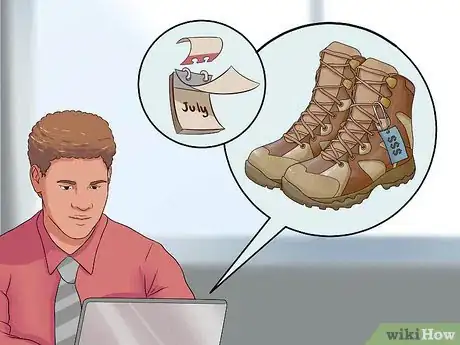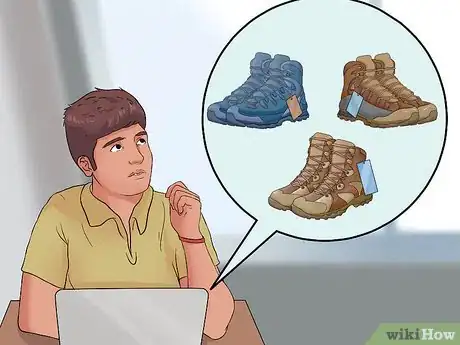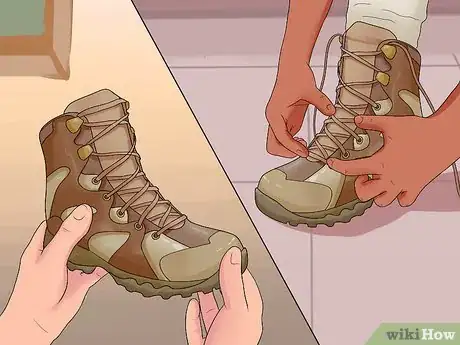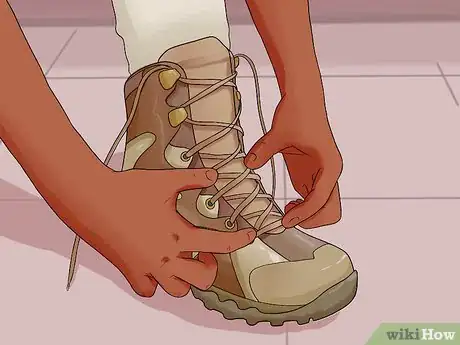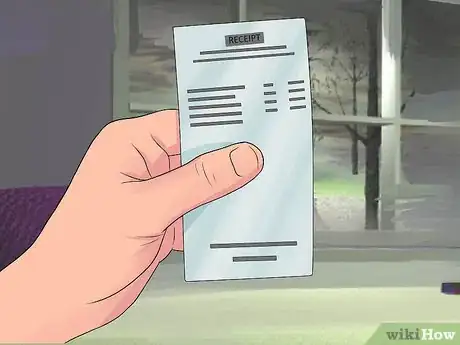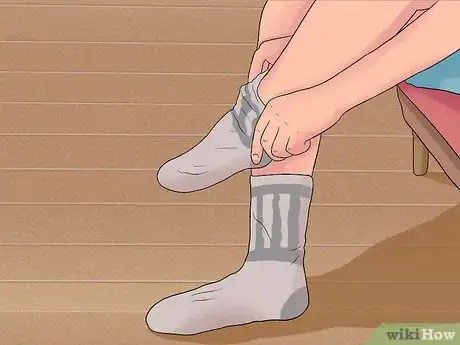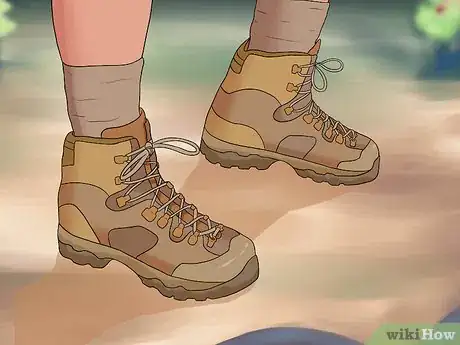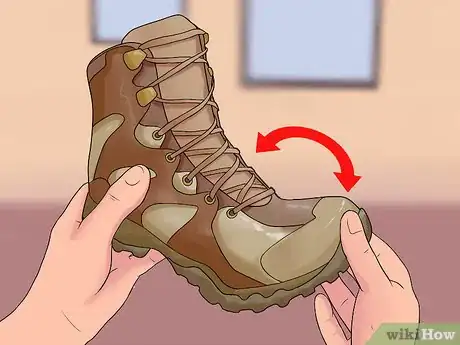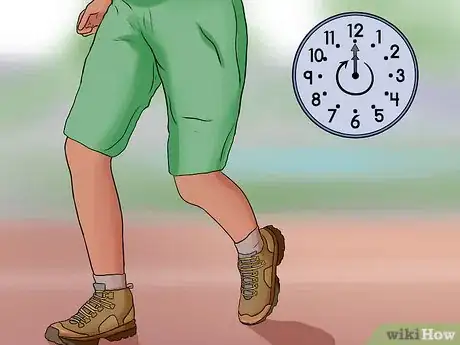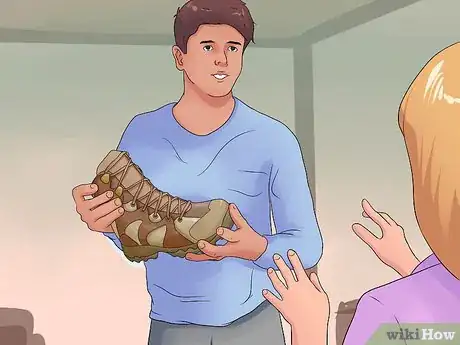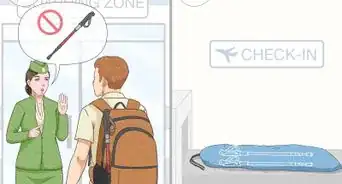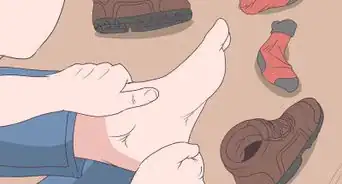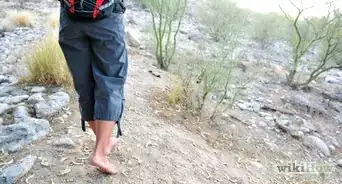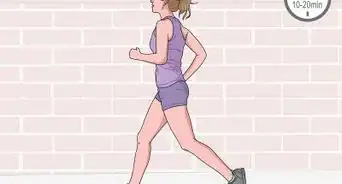This article was co-authored by Thomas Churchill. Thomas Churchill has been leading hiking and backpacking trips across California for the last five years as a Stanford Pre-Orientation Trip Leader and Adventure Program Guide. Most recently, Thomas was a Hiking Leader for 3 months at Stanford Sierra Conference Center, leading day hikes in the Desolation Wilderness of Northern California.
This article has been viewed 105,280 times.
When hiking, the comfort of your footwear is crucial to how much you enjoy the hike itself. Unfortunately, a brand-new pair of hiking boots will be too stiff at first to provide that comfort. Gradually break your boots in well before you wear them for any serious hikes.
Steps
Buying the Right Boots for You
-
1Go shopping at least a month before your hike.[1] If you schedule a specific trip in the near future, work backwards from that date. Since it can take weeks to properly break in a new pair of boots, allow yourself at least a month between the time of purchase and your first full-day hike in them. From the purchase date, work farther back in time to factor in an adequate amount for you to do some comparative shopping and test-fitting, according to your availability.
-
2Do some comparative shopping. Use the internet to research products or speak with sales staff to find the right boot for you. Consider what type of hiking you plan on doing. For instance, are you looking for an all-purpose pair of boots to wear whenever, or are you planning a specific hike along, say, the Appalachian Trail? Refine your search by factoring in the following:
- What distance does your average hike cover?
- What sort of terrain do you hike?
- What climate and weather conditions will you face?
Advertisement -
3Handle boots personally before buying. Once you have whittled your list down to a few favorites, visit sporting good stores, shoe outlets, department stores, or anywhere else that carries those boots, even if you plan on making your final purchase online. Wear the same socks that you use for hiking to the store. Also bring your insoles if you wear those too, so you can test each boot properly.[2]
-
4Make sure they hug your feet tightly. Take the time to lace them properly. Walk around the store as much as needed to judge how they fit. Since they will loosen up as you break them in, a brand-new pair of boots should grip your feet securely at first, but not so much that they pinch your feet to the point of causing pain, constricting movement, or interfering with blood circulation.
- An ideal pair of boots should fit snugly at all points, except for the toe of the boot, which should provide a little extra space in front to prevent your own toes from mashing up against the interior when descending hills. All other areas of the boots should grip your foot tightly so that your heel is kept firmly in place within the boot. [3]
-
5Keep the receipt. If you make your purchase in-store, hold onto the receipt in case you need to return your boots. If you find a cheaper price for the same pair online, familiarize yourself with the retailer’s return policy before completing your purchase. Either way, since even the most “perfect” pair of hiking boots will most likely feel uncomfortable to some degree when brand-new, hold onto whatever paperwork is needed for returns in case the boots show no signs of improving once you start breaking them in.
Breaking Your Boots In with Baby Steps
-
1Wear the right socks. When breaking in your boots, don’t put on a pair of dress socks just because they happen to be handy. Wear socks that are appropriate for hiking so your boots conform to your feet exactly as they will be dressed when you actually go hiking. If you don’t already own some, buy yourself a pair of thick socks made of wool or synthetic fibers, since thicker socks will last longer and these materials won’t retain as much sweat or moisture as cotton.[4]
- Also wear any insoles or arch supports that you might use for hiking.
-
2Wear your boots around the house. Treat your new hiking boots like indoor slippers for the first few days after purchase. Pad around inside the house while you cook meals, do chores, or simply pace back and forth from room to room. Avoid going outside or doing anything particularly messy or physically intensive. Keep your boots as a pristine as possible in case you need to return them if they continue to cause any severe discomfort after the first few days.
-
3Venture outside for brief walks. If padding around the house doesn’t cause any excessive pinching, rubbing, or other pain, expand your horizons. Take your boots outside for short excursions. Wear them down the block to the corner shop when you need to pick something up or take a stroll around the block each night. Wherever you go, be sure to keep it short at first so that you continue to break your boots in gradually.
-
4Pay attention to any pain. Your boots need time to break in, so keep your walks short at first so you can better identify sources of pain. Venturing too far too soon may cause blisters that won’t necessarily appear later on once your boots are properly broken in. For now, note where your boots seem to pinch or rub your feet the most. Pay attention to these areas over the coming days to keep tabs on how much or how little the situation improves.
Upping the Mileage
-
1Flex the soles. Once a crease begins to form along the top of each boot, roughly where your toes connect with the balls of your foot, take the boots off after your walks. Bend the boots toes up and down for a little while each day. Make the soles more flexible to decrease stiffness and allow your feet a wider range of movement. Be gentle as you do so, however, so you don’t overstretch the soles and tear them![5]
- Performing squats while wearing your boots will also help loosen the soles.
-
2Take longer walks. As short jaunts to the store or elsewhere become more comfortable in your boots, increase the length of your excursions bit by bit. Take 20 or 30 minute walks through the neighborhood each night. If your feet are feeling fine by the end of the week, use the weekend to take a longer hike through a nearby park. The following week, add another 10 or 15 minutes to your nightly walk. Be careful to increase the duration of each walk incrementally, so that you don’t end up hobbled in the middle of nowhere.
-
3Simulate hikes. Since trails typically aren’t as level or as smooth as sidewalks, take your boots off-road. Find short hills to put them through the motions of climbing. As your boots lose their stiffness, walk over rougher ground to test how they handle uneven surfaces. If you usually wear backpacks while hiking, wear them now with the typical amount of weight that you carry on hikes.[6]
-
4Continue until you wear them all day. Gradually increase the amount of use your boots receive each day until you are comfortably wearing them all day long. At this point, consider them broken in! Set them aside for hiking only so you don’t wear them out from casual use.
-
5Customize your boots if needed. If you continue to experience the same pain in the same area with no sign of improvement, bring your boots to a store that specializes in hiking equipment. Seek assistance from their boot-fitters. Describe the pain and ask what methods and/or modifications could be done to alleviate it.[7] Learn the leading factors that caused the pain to begin with so you know what to look out for when buying future pairs.
Community Q&A
-
QuestionI have new boots and I get pain around the ankle only on one boot. What can I do?
 Community AnswerIt might help to pad up the ankle that is painful just while you are breaking the new boots in. Failing that, try seeing a physiotherapist and take the boots with you so he/she can assess them. It's really important to be totally comfortable when you are hiking.
Community AnswerIt might help to pad up the ankle that is painful just while you are breaking the new boots in. Failing that, try seeing a physiotherapist and take the boots with you so he/she can assess them. It's really important to be totally comfortable when you are hiking. -
QuestionWhat if the boots start making my feet hurt?
 Community AnswerIf they are new, that is common. Your discomfort should improve with time and continued use. Pad up the feet at the pressure points while the material of the boots softens.
Community AnswerIf they are new, that is common. Your discomfort should improve with time and continued use. Pad up the feet at the pressure points while the material of the boots softens. -
QuestionMy left boot squeaks. What can I do to stop this?
 Community Answer1. Try sprinkling some baby powder under the insole. 2. Wear socks with your shoes. 3. Take care of your shoes. Oil your shoes if they are leather. 4. Fix any loose heels or soles. 5. Dry wet shoes thoroughly before wearing them again.
Community Answer1. Try sprinkling some baby powder under the insole. 2. Wear socks with your shoes. 3. Take care of your shoes. Oil your shoes if they are leather. 4. Fix any loose heels or soles. 5. Dry wet shoes thoroughly before wearing them again.
Warnings
- Don't forget to lace up your boots tightly and neatly, as you would when hiking. Any creases that set in the material while breaking the boots in are likely to remain for the life of the boot.⧼thumbs_response⧽
Things You'll Need
- New hiking boots
- Hiking socks
References
- ↑ http://www.idyllwild.com/boots.html
- ↑ http://www.outsideonline.com/1785061/how-do-i-break-my-hiking-boots
- ↑ http://www.patc.us/hiking/gear/boots.html
- ↑ http://www.hikingdude.com/hiking-socks.php
- ↑ http://www.mountainwarehouse.com/expert-advice/how-to-break-in-walking-boots
- ↑ http://www.mountainwarehouse.com/expert-advice/how-to-break-in-walking-boots
- ↑ http://www.outsideonline.com/1785061/how-do-i-break-my-hiking-boots
About This Article
To break in hiking boots, put on a pair of thick socks and wear your boots around the house to get used to walking around in them. When you feel comfortable in them, start taking short walks outside in the boots to run errands. As you're walking, pay attention to any pain or discomfort you feel in your feet or ankles, which can cause blisters. When the boot has a crease along the top where your toes meet your foot, begin flexing the sole up and down to remove any stiffness, and then start taking the boots on longer walks and excursions. For tips on picking the right boots for you and getting started with long trips, read on!
